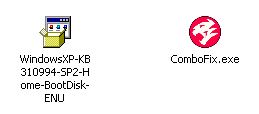Introduction
ComboFix is a program, created by sUBs, that scans your computer for known malware, and when found, attempts to clean these infections automatically. In addition to being able to remove a large amount of the most common and current malware, ComboFix also displays a report that can be used by trained helpers to remove malware that is not automatically removed by the program.
At this time ComboFix can only run on the following Windows versions:
- Windows XP (32-bit only)
- Windows Vista (32-bit/64-bit)
- Windows 7 (32-bit/64-bit)
- Windows 8 (32-bit/64-bit)
You should not run ComboFix unless you are specifically asked to by a helper. Also, due to the power of this tool it is strongly advised that you do not attempt to act upon any of the information displayed by ComboFix without supervision from someone who has been properly trained. If you do so, it may lead to problems with the normal functionality of your computer.
It should also be noted that when you run ComboFix it will automatically delete files from the following locations:
- Windows Recycle Bin
- Temporary Internet Files
- Temp Folder
If you store files that you wish to keep in one of these location, it is suggested that you move them to a safer location rather than relying on the above temporary storage locations.
Please note that this guide is the only authorized guide for the use of ComboFix and cannot be copied without permission from BleepingComputer.com and sUBs. Furthermore, the ComboFix program cannot be hosted at any other site without direct permission from the developer. It is also understood that the use of ComboFix is done at your own risk.
For those who wish to help finance the author's work, he is accepting contributions
via Paypal. You can contribute by clicking on the following image:
Using ComboFix
If you need help with malware removal, then please create a topic at one of the forums listed later in the guide and ask for help. Please note that each forum has different policies, so please be sure to read any pinned topics and rules for the particular forum about how you should go about receiving help. If a ComboFix log has been requested by a helper then please create one by following the instructions below.
The first thing you should do is print out this guide, as we will close all the open windows and programs, including your web browser, before starting the ComboFix program.
Next you should download ComboFix from the following URL:
ComboFix Download Link
To download ComboFix, click the link above, and at the page that opens, please click on the download link for ComboFix. When you click on the link you will see a download prompt similar to the one below.
Download ComboFix Prompt
Click on the Save button, and when it asks you where to save it, make sure you save it directly to your Windows Desktop. An image showing this is below.
Downloading ComboFix to the Desktop
When you have the Save as screen configured to save ComboFix.exe to the Desktop, click on the Save button. ComboFix will now start downloading to your computer. If you are on a dialup, this may take a few minutes. When ComboFix has finished downloading you will now see an icon on your desktop similar to the one below.
![]()
ComboFix Icon
We are almost ready to start ComboFix, but before we do so, we need to take some preventative measures so that there are no conflicts with other programs when running ComboFix. At this point you should close all open Windows and double-click on the ComboFix icon found on your desktop. Please note, that once you start ComboFix you should not click anywhere on the ComboFix window as it can cause the program to stall. In fact, when ComboFix is running, do not touch your computer at all. The scan could take a while, so please be patient.
Once you double-click on the icon, you may see a screen similar to the one below.
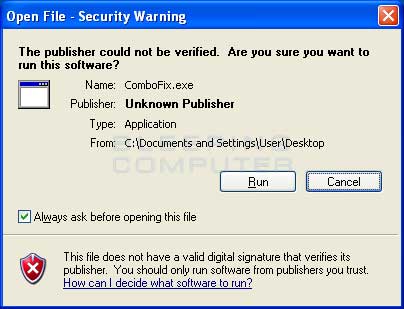
Windows Open File Security Warning
Windows is issuing this prompt because ComboFix does not have a digital signature. This is perfectly normal and safe and you can click on the Run button to continue. If you are using Windows Vista or Windows 7, and receive UAC prompt asking if you would like to continue running the program, you should press the Yes button.
You will now see the ComboFix disclaimer screen as shown below.
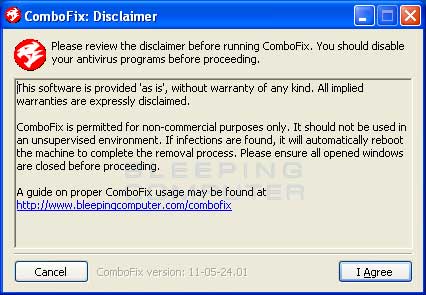
ComboFix Disclaimer
Please read through the disclaimer and if you do not agree to it, then please click on the Cancel button to exit the program. Otherwise, to continue you should click on the I agree button. If you clicked on I Agree, ComboFix will now install itself on to your computer. When it is done, a blue screen will appear as shown below.

ComboFix is Preparing to Run
ComboFix is now preparing to run. When it has finished ComboFix will automatically attempt to create a System Restore point so that if any problems occur while using the program you can restore back to your previous configuration. When ComboFix has finished creating the restore point, it will then backup your Windows Registry as shown in the image below.
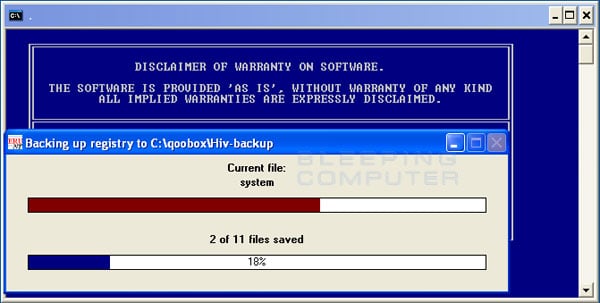
ComboFix is backing up the Windows Registry
Once the Windows Registry has finished being backed up, ComboFix will attempt to detect if you have the Windows Recovery Console installed. If you already have it installed, you can skip to this section and continue reading. Otherwise you will see the following message as shown below:

ComboFix Recovery Console
At the above message box, please click on the Yes button in order for ComboFix to continue. Please follow the steps and instructions given by ComboFix in order to finish the installation of the Recovery Console. Once it has finished installing, you will be presented with the screen shown below.

ComboFix Recovery Console Finished
You should now press the Yes button to continue. If at any time during the Recovery Console installation you receive a message stating that it failed to install, please allow ComboFix to continue with the scan of your computer. When it is done, and a log has been created, you can then perform the manual install of the Recovery Console using the steps found in the Manually installing the Windows Recovery Console section.
ComboFix will now disconnect your computer from the Internet, so do not be surprised or concerned if you receive any warnings stating that you are no longer on the Internet. When ComboFix has finished it will automatically restore your Internet connection.
ComboFix will now start scanning your computer for known infections. This procedure can take some time, so please be patient.

ComboFix is scanning the computer for infections
While the program is scanning your computer, it will change your clock format, so do not be concerned when you see this happen. When ComboFix is finished it will restore your clock settings to their previous settings. You will also see the text in the ComboFix window being updated as it goes through the various stages of its scan. An example of this can be seen below.
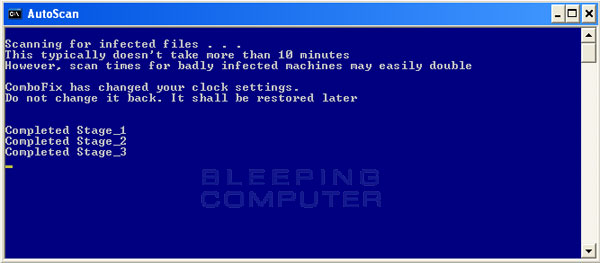
Stages of the ComboFix AutoScan
At the time of this writing there are a total of 50 stages as shown in the image below, so please be patient. The amount of stages will go up as time goes on, so if the amount of stages is different when you run it, please do not be concerned.
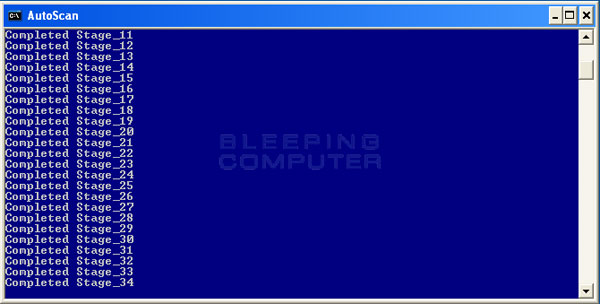
34th Stage of the ComboFix AutoScan
When ComboFix has finished running, you will see a screen stating that it is preparing the log report as shown below.

ComboFix is preparing the log report
This can take a while, so please be patient. If you see your Windows desktop disappear, do not worry. This is normal and ComboFix will restore your desktop before it is finished. Eventually you will see a new screen that states the program is almost finished and telling you the programs log file, or report, will be located at C:\ComboFix.txt. This can be seen in the image below.

ComboFix is almost done!
When ComboFix has finished, it will automatically close the program and change your clock back to its original format. It will then display the log file automatically for you as shown below.
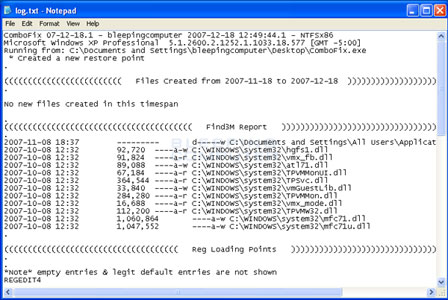
ComboFix Log File
You should now post this log as a reply to the topic where you were asked to run combofix. Your helper will now analyze this log and let you know what they would like you to do next. If you having problems connecting to the Internet after running Combofix, then please read the Manually restoring the Internet connection section.
It is possible that ComboFix, even on its first run, may have
fixed the problems you are having. We strongly suggest that you still post your
log into the topic that you are receiving help as you most likely will have
infections left over that your helper will need to analyze further.
How to uninstall ComboFix
Please note that if you uninstall ComboFix it will also remove all backups and quarantines that were created when ComboFix scanned and cleaned your computer. Therefore, only uninstall ComboFix when you are a hundred percent sure that your computer is operating correctly and that you no longer need any of the files that were backed up or quarantined.
To uninstall ComboFix from Windows XP please perform the following steps:
Click on the Start button (![]() ) and then select Run from the menu. This will open up the Run dialog box as shown in the image below:
) and then select Run from the menu. This will open up the Run dialog box as shown in the image below:
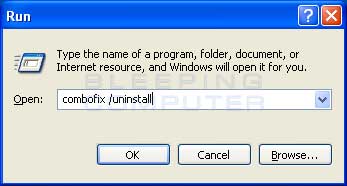
Windows XP Run Dialog
In the Open: field type combofix /uninstall, as shown in the image above. Please note that there is a space between combofix and /uninstall. Once you have typed this in, click on the OK button. A Open File security warning will appear asking if you are sure you want to run ComboFix. Please click on the Run button to start the program.
ComboFix will now uninstall itself from your computer and remove any backups and quarantined files. When it has finished you will be greeted by a dialog box stating that ComboFix has been uninstalled. You can now delete the ComboFix.exe program from your computer. ComboFix has now been uninstalled from your Windows XP computer.
To uninstall ComboFix from Windows Vista or Windows 7 please perform the following steps:
Click on the Start button (![]() ) and then in the Search field enter combofix /uninstall, as shown in the image below with the blue arrow. Please note that there is a space between combofix and /uninstall.
) and then in the Search field enter combofix /uninstall, as shown in the image below with the blue arrow. Please note that there is a space between combofix and /uninstall.
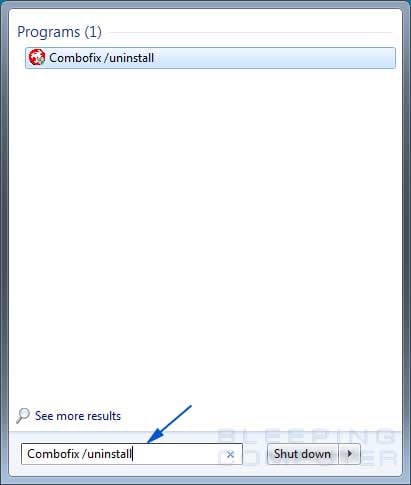
Windows 7 Start Menu
Once you have typed this in, press Enter on your keyboard. A Open File security warning will appear asking if you are sure you want to run ComboFix. Please click on the Run button to start the program.
ComboFix will now uninstall itself from your computer and remove any backups and quarantined files. When it has finished you will be greeted by a dialog box stating that ComboFix has been uninstalled. You can now delete the ComboFix.exe program from your computer. ComboFix has now been uninstalled from your Windows Vista or Windows 7 computer.
Forums to receive help analyzing ComboFix logs
Below is a list of forums where there are authorized helpers who understand and can analyze ComboFix logs. We have categorized the forums by language as ComboFix is used internationally.
-
English Forums
- Bleeping Computer
- Tech Support Forum
- SpywareInfo
- GeeksToGo
- SpywareHammer
- SpywareWarrior
- DSLReports
- SpyKiller
- WhatTheTech
- Safer-Networking
- D-A-L
- Tech Support Guy
- PCPitstop
- CyberTechHelp
- MalwareRemoval
- Webuser
- Gladiator Security
- 247fixes
- TeMerc Internet Countermeasures
- MajorGeeks
- Aumha
-
Turkish Forums
- Bilisimplatformu.com
-
Dutch Forums
- Mivercon.be
- AntiSpywareOffensief
- HijackThis.nl
-
German Forums
- Trojaner-Board.de
- HijackThis.de
- PCMasters
-
Spanish Forums
- InfoSpyware
-
Portuguese Forums
- Forum Clube do Hardware
-
Danish Forums
- Spywarefri
-
Finnish Forums
- Virustorjunta
-
Russian Forums
- SafeZone.cc
-
Polish Forums
- FixItPC.pl
Manually installing the Windows Recovery Console
In the event that the automatic install of Recovery Console was not possible, you should follow the steps listed here in order to manually install it. The Windows recovery console is a tool that will allow you to boot up into a special recovery mode that allows us to help you in the case that your computer has a problem after an attempted removal of malware. If you use Windows XP and have a Windows CD, then you can follow the instructions found in the tutorial listed below.
How to install and use the Windows XP Recovery Console
Windows Vista and Windows 7 users do not have the Windows Recovery Console, but instead have a new recovery tool called the System Recovery Environment. This new recovery tool is sometimes preinstalled on your computer via your computer manufacturer and is accessed from the Windows boot menu. For those that do not have it preinstalled, you will instead need to boot your computer via your Windows DVD in order to access it.
For details on how to access the Windows 7 and Windows Vista System Recovery Environment, please see these tutorials:
How to use the Command Prompt in the Vista Windows Recovery Environment.
How to use the Windows 7 System Recovery Environment Command Prompt
If you use Windows XP and do not have the Windows CD, ComboFix includes a method of installing the Windows Recovery console by downloading a file from Microsoft. To install the Windows Recovery Console when you do not have the Windows XP CD, please follow these instructions:
- Click on the following link to go to Microsoft's Web site:
http://support.microsoft.com/kb/310994 - At that page, scroll down and click on the appropriate download for your
version of Windows XP (Home or Professional) and the service pack level that
you have installed. When you click on the link to download the file, make
sure you save it directly to your desktop. If you are using Windows XP Service
Pack 3 (SP3), then select the Service Pack 2 download. If you are using Windows
XP Media Center, then you should select the Windows XP Pro Service Pack 2
download. If you are unsure what version of Windows you have and what Service
Pack is installed, you can follow these instructions to gain that information.
- Click on the Start button.
- Click on the Run menu option.
- In the Open: field type the following: sysdm.cpl
and then click on the OK button.
- A screen will appear showing information about your installation. Under
the System: category you should see your Windows version
and the installed Service Pack. When you are done determining this information
continue with Step 2.
- Click on the Start button.
- Once the Microsoft file has finished downloading, you should drag it on
top of the ComboFix icon and let your mouse button go. This is shown in the
following image.

- ComboFix will now automatically install the Windows Recovery Console onto your computer, which will show up as a new option when booting up your computer. Do not select the Windows Recovery Console option when you start your computer unless requested to by a helper.
Once the Windows Recovery Console has finished installed, ComboFix will open a prompt stating that it was installed and asking if you would like to proceed with scanning your computer. If you wish to continue, then press the Yes button and continue reading the tutorial from here.
Manually restoring the Internet connection
If, by some chance, you no longer have access to your Internet connection after running ComboFix then the first thing to try is to reboot your computer. This step alone should fix the vast majority of issues with no Internet connection after running ComboFix. If you still do not have an Internet connection after rebooting then please perform the following steps:
- Click on the Start button.
- Click on the Settings menu option.
- Click on the Control Panel option.
- When the Control Panel opens, double-click on the Network Connections icon. If your Control Panel is set to Category View, then double-click on Network and Internet Connections and then click on Network Connections at the bottom.
- You will now see a list of available network connections. Locate the connection for your Wireless or Lan adapter and right-click on it.
- You will now see a menu similar to the image below. Simply click on the Repair menu option.

Repair Internet Connection - Let the repair process perform its tasks and when it has finished, your Internet connection should be working again.
Alternatively, if your network icon also appears on the Windows taskbar, then you can repair it by right-clicking on the icon and selecting Repair as shown below.
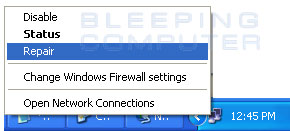
Repair Internet connection via Tray Icon
If you still do not have an Internet connection after performing these two tasks, then you may want to ask for help in our forums.
